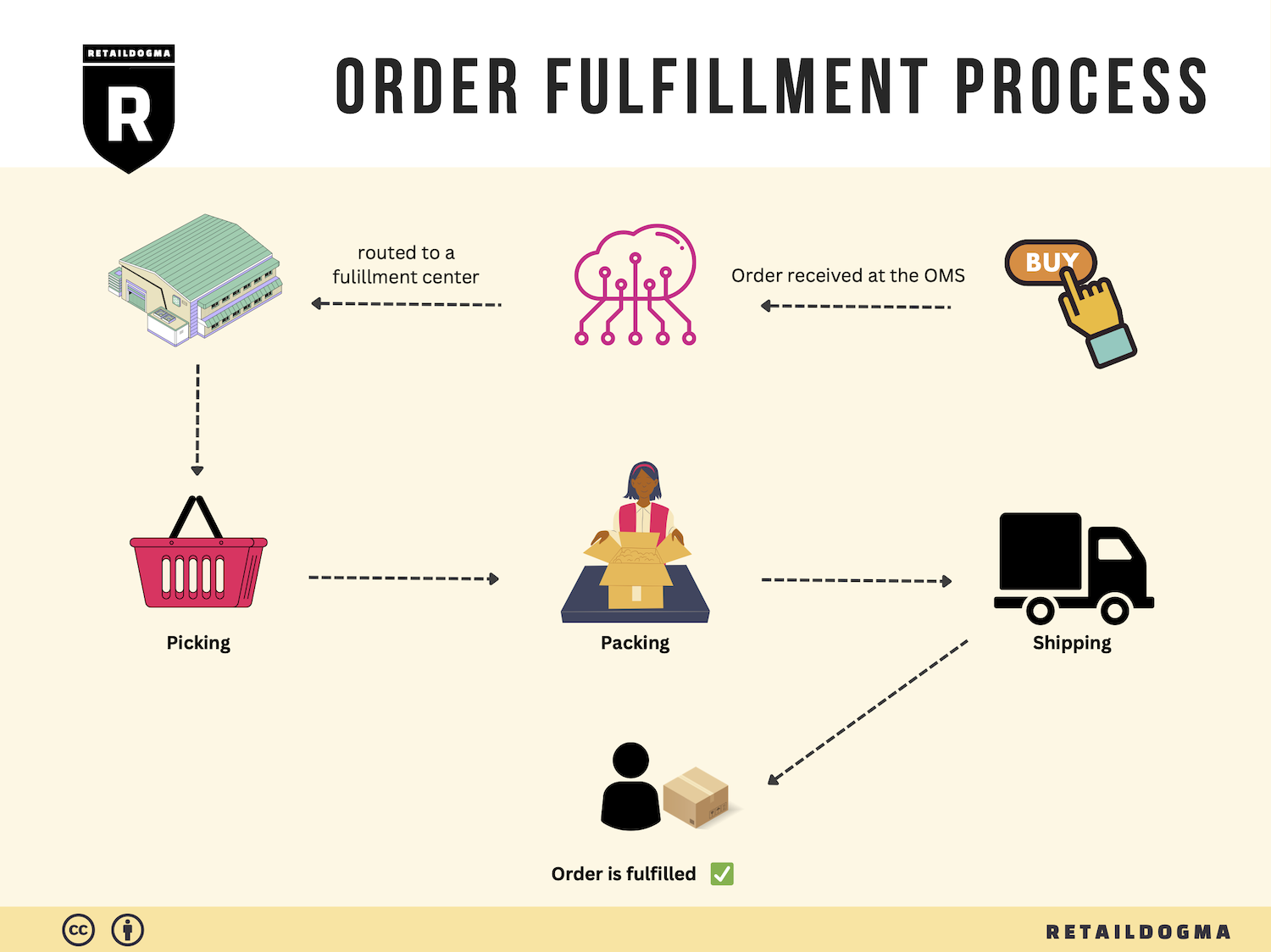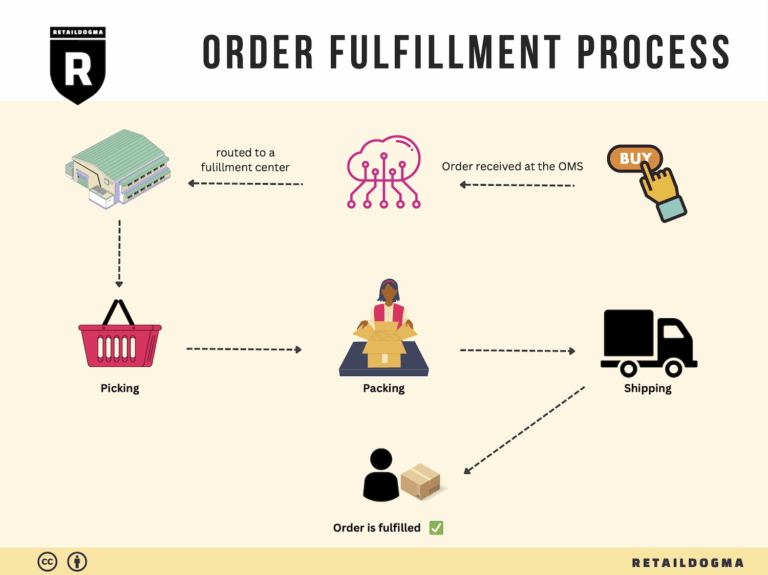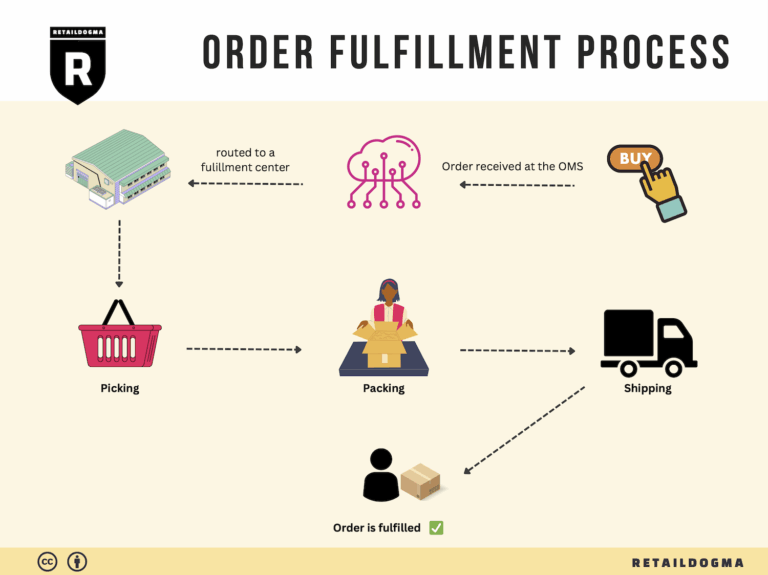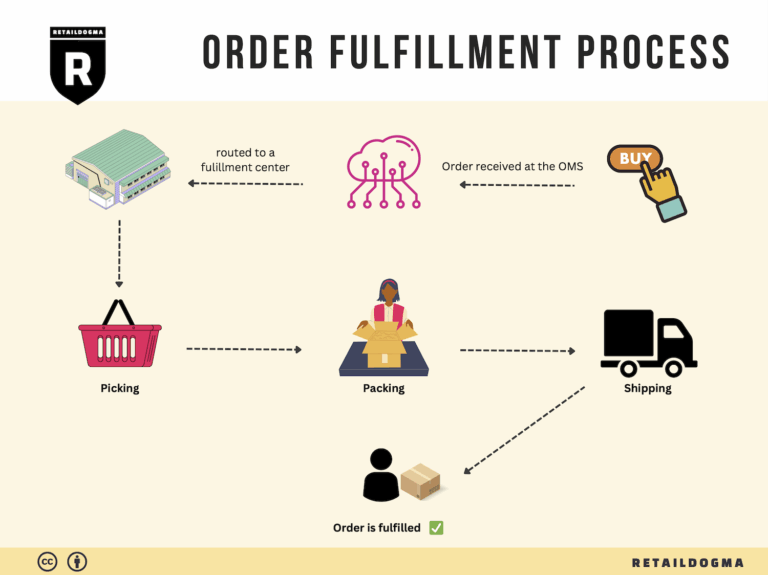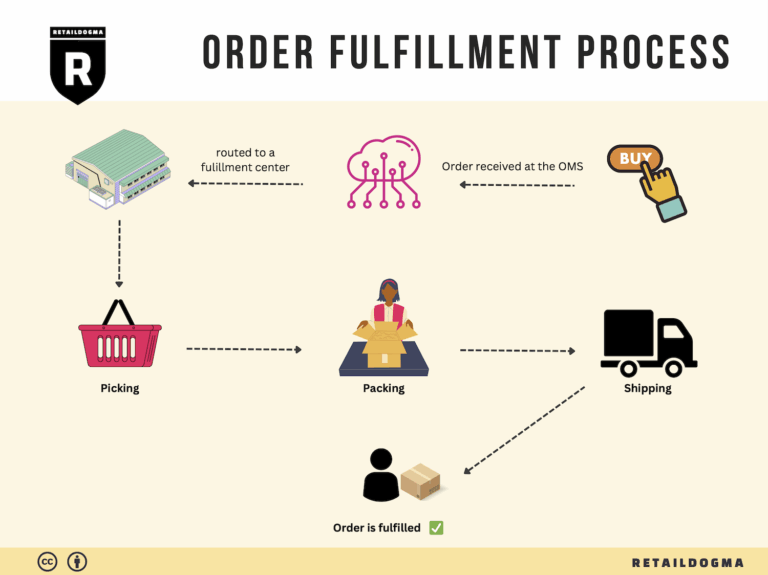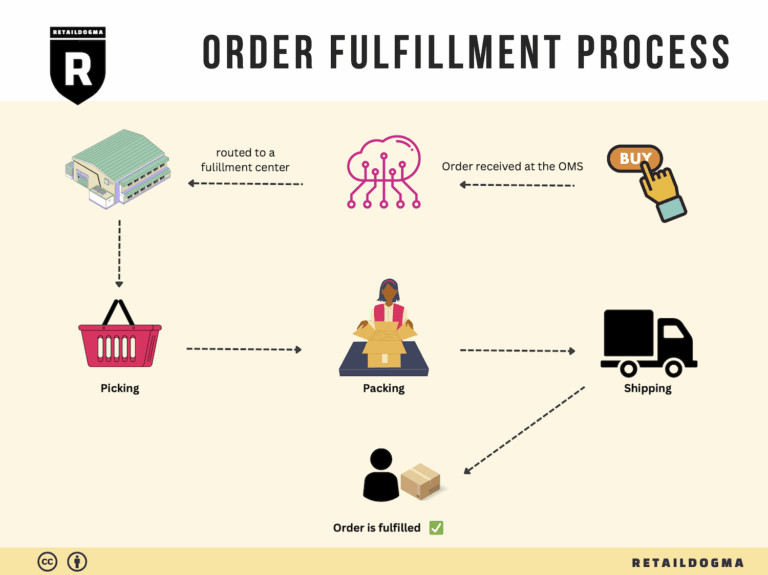What Is A Fulfillment Center? A Complete Guide (2025)
What is E-commerce Fulfillment? An Introduction for Growing Businesses
Understanding the Challenges of E-commerce Fulfillment
As e-commerce businesses grow, many owners find themselves overwhelmed by the complexities of packing and shipping orders. The excitement of increased sales can quickly turn into stress when faced with the logistical challenges of fulfilling those orders efficiently. Whether you’re a small startup or an established brand, the fulfillment process—essentially, the act of getting a product from your warehouse to your customer—can become a significant pain point.
Defining E-commerce Fulfillment
E-commerce fulfillment encompasses all the steps involved in receiving, processing, and delivering an order to the customer. This process includes inventory management, order processing, picking and packing items, shipping, and handling returns. As your business scales, managing these tasks in-house can become daunting, leading to delays, errors, and customer dissatisfaction.
What This Guide Will Cover
In this guide, we will explore various fulfillment models that can help streamline your operations. You’ll learn about:
- Third-Party Logistics (3PL): Outsourcing your fulfillment to a specialized provider can save you time and resources, allowing you to focus on growing your business.
- Fulfillment by Amazon (FBA): Leveraging Amazon’s vast logistics network can provide your products with increased visibility and faster shipping times.
- Core Services: Understanding the essential services offered by fulfillment partners, such as inventory storage, order processing, and customer support.
- Choosing the Right Partner: Key factors to consider when selecting a fulfillment partner, including their technology, customer service, and ability to scale with your business.
- Pricing Structures: An overview of common pricing models in fulfillment, helping you make informed financial decisions.
Empowering Your Business Decisions
The goal of this guide is to empower e-commerce business owners and operations managers to make smart, strategic decisions about their logistics. By understanding the nuances of e-commerce fulfillment and exploring the available options, you can optimize your supply chain, enhance customer satisfaction, and ultimately drive growth. Embrace the fulfillment process as a vital component of your e-commerce strategy, and unlock the potential for your business to thrive in a competitive market.
What You’ll Learn In This Guide
- What is E-commerce Fulfillment? An Introduction for Growing Businesses
- The Order Fulfillment Process: From ‘Buy’ Button to Customer’s Door
- Comparing Fulfillment Models: In-House vs. 3PL vs. Dropshipping
- A Deep Dive into Amazon FBA: Pros, Cons, and Who It’s For
- Core Services Offered by Fulfillment Centers
- How to Choose a Fulfillment Partner: A 6-Point Checklist
- Understanding Fulfillment Pricing: A Breakdown of Common Fees
- Frequently Asked Questions (FAQs) about Fulfillment
- Conclusion: Is Outsourcing Fulfillment the Right Move for Your Business?
- Important Disclaimer
The Order Fulfillment Process: From ‘Buy’ Button to Customer’s Door
1. Receiving Inventory
The order fulfillment process begins with receiving inventory. This step involves the acceptance of products from suppliers into the warehouse. Upon arrival, each shipment is checked against the purchase order to ensure that the correct items and quantities have been delivered. This is where the concept of SKU (Stock Keeping Unit) comes into play. SKUs are unique identifiers for each product, making it easier to track inventory levels and manage stock.
Importance: Proper receiving of inventory is critical to maintaining accurate stock levels and ensuring that products are available for order fulfillment. Any discrepancies at this stage can lead to stockouts or overstock situations, both of which can negatively impact customer satisfaction and operational efficiency.
2. Warehouse Storage
Once inventory is received, it needs to be stored effectively within the warehouse. Products are organized based on various criteria, such as size, weight, or demand frequency. Efficient warehouse layout and storage systems (e.g., shelving, bins, and pallets) are crucial for maximizing space and accessibility. Implementing a Warehouse Management System (WMS) can help automate this process, allowing for real-time tracking of inventory locations.
Importance: Effective warehouse storage minimizes the time required to locate and retrieve items during the order picking process. A well-organized warehouse reduces the likelihood of errors and improves overall productivity, ensuring that products can be quickly accessed when an order is placed.
3. Order Picking
When a customer places an order, the next step is order picking. This involves selecting the correct items from the warehouse to fulfill the order. A pick list, which details the items and quantities needed for each order, is generated to guide the picking process. Various picking methods, such as single order picking, batch picking, or zone picking, can be employed depending on the volume of orders and warehouse layout.
Importance: The order picking stage is one of the most labor-intensive parts of the fulfillment process. Efficient picking methods and accurate pick lists are essential to ensure that orders are filled correctly and promptly. Any errors during this stage can lead to customer dissatisfaction, returns, and increased operational costs.
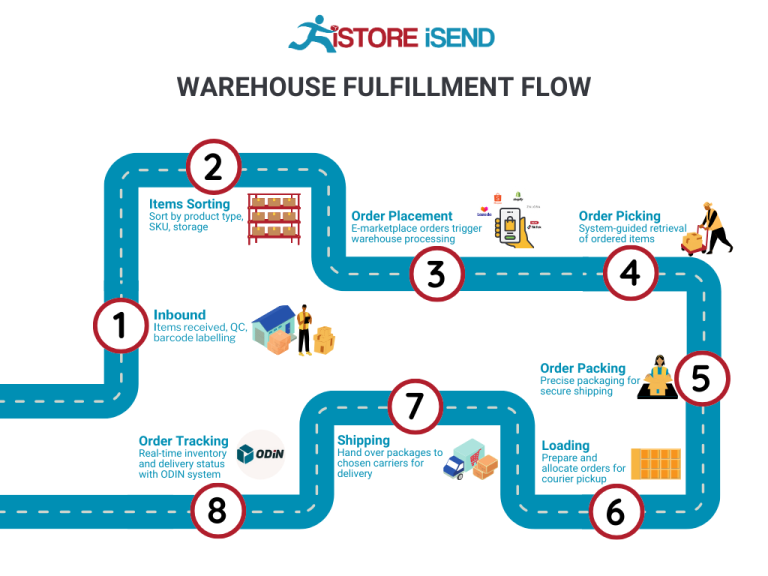
4. Order Packing
After the items have been picked, they move to the packing station. During this stage, products are carefully packed for shipment. This includes selecting appropriate packing materials, such as boxes, bubble wrap, or packing peanuts, to protect the items during transit. It is also the time to include necessary documentation, such as packing slips or invoices.
Importance: Proper order packing is vital to ensure that products arrive at the customer’s door in perfect condition. Effective packing minimizes the risk of damage during shipping, reduces return rates, and enhances the overall customer experience. Additionally, packing methods can impact shipping costs, so optimizing this process can lead to significant savings.
5. Shipping & Delivery
The final step in the order fulfillment process is shipping and delivery. Once orders are packed, they are labeled and handed over to a carrier for transportation. Businesses must choose the right shipping methods and partners based on factors like cost, speed, and reliability. Tracking systems should be implemented to provide customers with real-time updates on their shipment status.
Importance: Timely and reliable shipping is crucial for customer satisfaction. In today’s e-commerce landscape, customers expect fast delivery times, and businesses that can meet these expectations stand to gain a competitive advantage. Efficient shipping processes not only enhance customer experience but also build trust and loyalty, which are essential for long-term success.
By understanding and optimizing each step of the order fulfillment process, e-commerce businesses can significantly improve their operational efficiency, reduce costs, and enhance customer satisfaction. Each step, from receiving inventory to shipping and delivery, plays a vital role in ensuring that customers receive their orders accurately and on time.
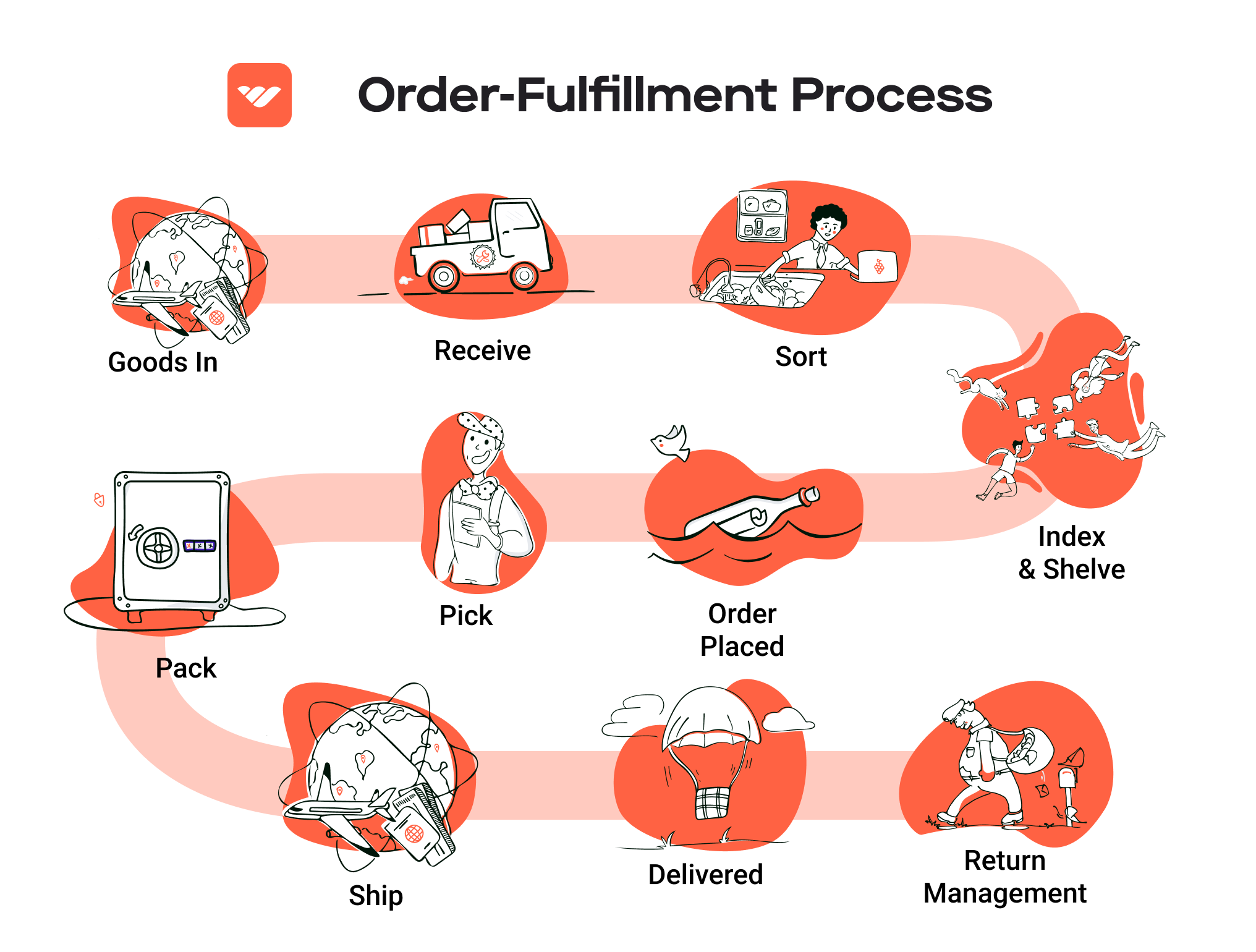
Comparing Fulfillment Models: In-House vs. 3PL vs. Dropshipping
Fulfillment Model Comparison
| Model | Who Handles Inventory | Best For (Business Stage) | Key Advantage | Key Disadvantage |
|---|---|---|---|---|
| In-House Fulfillment | Business itself | Established businesses | Full control over inventory and processes | High overhead costs and resource demands |
| Third-Party Logistics (3PL) | Outsourced logistics provider | Growing and scaling businesses | Scalability and reduced operational burden | Less control over inventory and logistics |
| Dropshipping | Supplier/vendor | Startups and low-capital firms | Minimal upfront investment and low risk | Lower profit margins and reliance on suppliers |
In-House Fulfillment
In-house fulfillment refers to the model where a business manages its own inventory and logistics operations. This means that the company is responsible for storing, picking, packing, and shipping its products. Typically, established businesses with a stable cash flow and a significant volume of sales opt for this model. The primary advantage of in-house fulfillment is the complete control it offers over the entire process. Businesses can customize their packing and shipping methods, ensuring that the customer experience aligns with their brand values. Additionally, having direct oversight allows for quick adjustments to inventory management and order processing. However, this model also comes with notable disadvantages, including high overhead costs associated with warehousing, staffing, and technology investments. Furthermore, as demand fluctuates, managing inventory can become a complex challenge, potentially leading to overstock or stockouts.
Third-Party Logistics (3PL)
Third-party logistics (3PL) is a fulfillment model where businesses outsource their inventory management and shipping processes to a specialized logistics provider. This is particularly beneficial for growing and scaling businesses that may not have the resources or expertise to handle fulfillment internally. 3PL providers offer a range of services, including warehousing, order fulfillment, and shipping, allowing businesses to focus on their core operations such as product development and marketing. The key advantage of utilizing a 3PL is scalability; as sales increase, businesses can easily ramp up logistics capabilities without the need for significant capital investment in infrastructure. However, this model does come with a trade-off. Businesses often have less control over their inventory and logistics processes, which can lead to inconsistencies in service quality and customer experience. Additionally, partnering with a 3PL typically involves service fees that can impact overall profit margins.
Dropshipping
Dropshipping is a fulfillment method where the retailer does not hold inventory but instead relies on suppliers to fulfill customer orders directly. This model is particularly attractive for startups and businesses with limited capital, as it requires minimal upfront investment and eliminates the need for warehousing. Retailers can offer a wide range of products without the financial risk associated with inventory management. The primary advantage of dropshipping is the low barrier to entry; entrepreneurs can start selling products without the need for substantial investment in inventory or fulfillment infrastructure. However, dropshipping also presents significant challenges. Profit margins can be lower compared to traditional models, as retailers must share revenue with suppliers. Additionally, reliance on third-party suppliers can lead to issues with stock availability, shipping times, and product quality, which can ultimately impact customer satisfaction and brand reputation. Retailers must therefore carefully vet their suppliers and maintain strong communication to mitigate these risks.
Conclusion
Choosing the right fulfillment model is critical for e-commerce businesses looking to scale efficiently. In-house fulfillment offers control but at a higher cost, while 3PL provides scalability with less oversight. Dropshipping presents a low-risk entry point for new entrepreneurs but comes with its own set of challenges. Evaluating these models against your business goals, operational capabilities, and market demands will help ensure that your fulfillment strategy supports your growth objectives effectively.
A Deep Dive into Amazon FBA: Pros, Cons, and Who It’s For
What is Fulfillment by Amazon (FBA)?
Fulfillment by Amazon (FBA) is a logistics service provided by Amazon that allows sellers to store their products in Amazon’s fulfillment centers. Amazon takes on the responsibility of storing, packing, and shipping products directly to customers. This service also includes customer service and returns handling, which can significantly reduce the operational burden on sellers.
When a customer places an order for a product fulfilled by FBA, Amazon picks, packs, and ships the item on behalf of the seller. Additionally, FBA sellers can benefit from Amazon’s extensive logistics network, which includes same-day delivery and two-day shipping options for Prime members. This service not only enhances the seller’s operational efficiency but also improves customer satisfaction through faster delivery times.
How FBA Works
- Product Listing: Sellers create product listings on Amazon, indicating that they want to use FBA.
- Inventory Shipment: Sellers send their products to Amazon’s fulfillment centers. They can choose to send their inventory to multiple locations to optimize shipping times and costs.
- Storage: Amazon stores the inventory in its warehouses. Sellers are charged for storage based on the space their products occupy.
- Order Fulfillment: When a customer orders a product, Amazon handles the picking, packing, and shipping processes. The seller is notified of the sale.
- Customer Service: Amazon manages all customer service inquiries and returns for FBA products, allowing sellers to focus on other aspects of their business.
Pros of FBA
1. Prime Eligibility
One of the most significant advantages of using FBA is that products become eligible for Amazon Prime. This can lead to increased visibility and sales, as Prime members often prefer items that qualify for their membership benefits, including free two-day shipping.
2. Customer Trust
Amazon is a trusted brand among consumers. By using FBA, sellers benefit from Amazon’s reputation for reliable service, which can enhance customer trust and increase conversion rates. Customers are more likely to purchase from sellers whose products are fulfilled by Amazon due to the assurance of quality service.
3. Multi-Channel Fulfillment
FBA allows sellers to fulfill orders from multiple sales channels, not just Amazon. This means that if a seller has their own website or sells on other platforms, they can still use Amazon’s fulfillment services, streamlining their logistics operations across different sales channels.
4. Simplified Logistics
FBA simplifies the logistics process for sellers. Amazon handles storage, shipping, and customer service, allowing sellers to concentrate on product development and marketing. This can be particularly beneficial for small businesses that may not have the resources to manage these functions independently.
5. Scalability
Using FBA can help businesses scale quickly. As demand for products grows, sellers can easily increase their inventory without needing to invest heavily in warehouse space or logistics capabilities.
Cons of FBA
1. High Fees
While FBA offers numerous advantages, it also comes with high fees. Sellers must pay for storage space, fulfillment fees per item, and additional costs for long-term storage. These fees can significantly impact profit margins, especially for low-cost items.
2. Strict Inventory Rules
Amazon enforces strict inventory management rules. Sellers must maintain accurate stock levels and adhere to Amazon’s policies regarding inventory performance. Failure to comply can lead to penalties or even account suspension.
3. Commingling Risks
FBA products are often commingled, meaning that sellers’ inventory is stored together with that of other sellers. This can lead to issues such as receiving the wrong product or dealing with counterfeit items. While Amazon has measures in place to mitigate these risks, it remains a concern for some sellers.
4. Limited Control over Shipping
While Amazon’s logistics capabilities are impressive, sellers have limited control over the shipping process. This can be problematic if sellers want to offer customized shipping options or if they have specific branding requirements for packaging.
5. Dependency on Amazon
Relying on FBA can create a dependency on Amazon for sales and fulfillment. This can be risky, as any changes in Amazon’s policies or algorithms can directly impact a seller’s business. Diversifying sales channels is essential to mitigate this risk.
Who is FBA Best For?
Fulfillment by Amazon is best suited for:
- Small to Medium-Sized Businesses: Businesses that lack the resources to manage logistics independently can benefit greatly from FBA’s streamlined processes.
- Sellers with High Sales Volume: Sellers who anticipate high sales volume, especially during peak seasons, can leverage FBA’s efficient shipping and handling to meet customer demand.
- E-commerce Startups: New entrants in the e-commerce space can use FBA to establish a presence on Amazon without the burden of logistics management, allowing them to focus on product quality and marketing.
- Businesses Looking to Scale: Companies aiming for rapid growth can utilize FBA’s scalability to manage increasing inventory and order volumes without significant upfront investment in logistics infrastructure.
In conclusion, Fulfillment by Amazon offers a mix of benefits and challenges for e-commerce sellers. By understanding how FBA works and weighing its pros and cons, businesses can make informed decisions about whether to integrate this service into their operations.
Core Services Offered by Fulfillment Centers
Inventory Management & Warehousing
Effective inventory management is the backbone of a successful e-commerce operation. Fulfillment centers offer sophisticated inventory management systems that allow businesses to track stock levels in real time, ensuring that they are neither overstocked nor understocked. This service typically involves the use of advanced software that integrates with e-commerce platforms to provide a seamless overview of inventory.
The benefits of robust inventory management are manifold. First, it minimizes the risk of stockouts, which can lead to lost sales and customer dissatisfaction. With accurate inventory data, businesses can make informed purchasing decisions, helping to optimize cash flow and reduce holding costs. Additionally, effective warehousing solutions provided by fulfillment centers enable businesses to store products in strategically located facilities, reducing shipping times and costs, which is crucial for meeting customer expectations in today’s fast-paced market.
Pick and Pack Services
Pick and pack services are vital for the efficiency of order fulfillment. This process involves selecting the right products from the warehouse based on customer orders and then packing them appropriately for shipment. Fulfillment centers employ trained staff and automated systems to streamline this process, ensuring that orders are fulfilled accurately and swiftly.
The key advantage of pick and pack services is the enhancement of order accuracy and speed. Errors in picking can lead to returns and customer dissatisfaction, impacting brand reputation. By utilizing a fulfillment center, e-commerce businesses can leverage professional packing services that not only ensure accuracy but also optimize packaging for cost-effectiveness and sustainability. This service can significantly reduce the time from order placement to delivery, thereby improving customer satisfaction and encouraging repeat business.
Kitting and Assembly
Kitting and assembly services involve the grouping of various products into a single package or kit, which is particularly beneficial for businesses that sell bundled products or promotional items. Fulfillment centers can manage the assembly of these kits, ensuring that all components are included and packaged properly before shipping.
This service offers numerous benefits, particularly in terms of marketing and operational efficiency. By providing ready-to-ship kits, businesses can simplify their inventory management and reduce the time spent on individual item processing. Kitting also allows companies to create unique product offerings that can enhance customer appeal, such as gift sets or themed bundles. Furthermore, outsourcing kitting and assembly to a fulfillment center frees up internal resources, allowing businesses to focus on core activities like product development and customer engagement.
Returns Management (Reverse Logistics)
Returns management, or reverse logistics, is an often-overlooked aspect of e-commerce fulfillment that can significantly impact customer satisfaction and operational efficiency. Fulfillment centers provide comprehensive returns management services that streamline the process of handling product returns, including inspections, restocking, and processing refunds or exchanges.
The benefits of efficient returns management are substantial. First, a well-structured returns process enhances the customer experience, as shoppers are more likely to make purchases when they know they can easily return items if necessary. Additionally, effective returns management can reduce the costs associated with returns, such as shipping and restocking fees. Fulfillment centers often have established processes to quickly evaluate returned products, allowing businesses to determine whether items can be restocked or need to be disposed of. This quick turnaround not only preserves inventory value but also helps maintain accurate stock levels, ultimately leading to improved operational efficiency.
In conclusion, partnering with a fulfillment center for these core services allows e-commerce businesses to scale efficiently while focusing on growth strategies. From inventory management to returns processing, the expertise and resources provided by fulfillment centers can enhance operational performance, improve customer satisfaction, and drive sales. By leveraging these services, businesses can position themselves for long-term success in the competitive e-commerce landscape.
How to Choose a Fulfillment Partner: A 6-Point Checklist
Location & Warehouse Network
Importance:
The geographical location of your fulfillment partner’s warehouses can significantly impact shipping times and costs. A partner with multiple locations, especially near major consumer markets, can expedite deliveries and reduce transportation expenses.
Questions to Ask:
1. Where are your warehouses located, and how many do you have?
2. Do you have a network of warehouses that can cover my target markets effectively?
3. How do you determine which warehouse will fulfill an order?
4. Can you accommodate seasonal fluctuations in demand by utilizing different warehouse locations?
Technology & Integrations
Importance:
In today’s e-commerce environment, seamless technology integration is crucial for efficient operations. Your fulfillment partner should provide advanced technology solutions that sync with your e-commerce platform, enabling real-time inventory tracking, order management, and reporting.
Questions to Ask:
1. What fulfillment technology do you use, and how does it integrate with major e-commerce platforms?
2. Can your system provide real-time inventory updates and order tracking?
3. What analytics and reporting tools do you offer to help us monitor performance?
4. Are there options for custom integrations if needed?
Specializations (e.g., Cold Storage, Oversized Items)
Importance:
Different products require different handling and storage solutions. If you deal with perishable goods, fragile items, or oversized products, it’s essential to partner with a fulfillment provider that specializes in these areas.
Questions to Ask:
1. Do you offer specialized services such as cold storage or handling oversized items?
2. What certifications do you have for handling specific types of products?
3. Can you provide examples of how you have successfully managed unique fulfillment challenges?
4. How do you ensure compliance with industry regulations regarding special product categories?
Scalability & Capacity
Importance:
As your business grows, your fulfillment needs will change. Choosing a partner with the ability to scale operations efficiently is crucial to accommodate increased order volumes without compromising service quality.
Questions to Ask:
1. How do you handle scaling operations during peak seasons or unexpected demand surges?
2. What is your current capacity, and how quickly can you expand it if necessary?
3. Do you have contingency plans in place for unexpected growth or operational disruptions?
4. Can you provide references from businesses that have scaled with you?
Pricing and Contracts
Importance:
Understanding the cost structure of your fulfillment partner is vital for budgeting and financial forecasting. Transparent pricing helps avoid hidden fees that can erode your margins.
Questions to Ask:
1. Can you provide a detailed breakdown of your pricing model?
2. Are there additional fees for services such as storage, pick and pack, or returns processing?
3. What are the terms of your contracts, and what is your policy for contract termination?
4. Do you offer flexible pricing models based on order volume or specific services?
Customer Support & Reviews
Importance:
Effective customer support is essential for addressing issues quickly and maintaining smooth operations. Additionally, reviews and testimonials can provide insight into the partner’s reliability and service quality.
Questions to Ask:
1. What customer support options do you provide (e.g., phone, email, chat)?
2. What is your average response time for support inquiries?
3. Can you share customer testimonials or case studies that highlight your service quality?
4. How do you handle complaints or service disruptions?
Conclusion
Choosing the right fulfillment partner is a critical decision that can significantly affect your e-commerce operations. By using this checklist, you can ensure you evaluate potential partners thoroughly and find one that aligns with your business needs and growth aspirations. Always remember to prioritize communication and transparency during the selection process, as these factors will contribute to a successful partnership long-term.
Understanding Fulfillment Pricing: A Breakdown of Common Fees
Initial Setup Fees
Initial setup fees are one-time charges that e-commerce businesses incur when establishing a relationship with a fulfillment service. These fees cover the costs associated with onboarding your business into their system. This can include:
- Account Setup: Creating your online account and integrating it with their technology.
- Inventory Onboarding: Adding your products into their inventory management system, which may require data entry and product photography.
- System Configuration: Customizing the fulfillment service’s software to align with your specific business processes, including shipping preferences and order management settings.
The amount charged as an initial setup fee can vary significantly depending on the complexity of your needs and the fulfillment provider’s pricing structure. It’s essential to clarify what is included in these fees upfront and to ensure there are no hidden costs.
Receiving Fees
Receiving fees are charges applied when your inventory arrives at the fulfillment center. These fees cover the labor and resources needed to unload, inspect, and process your products into the warehouse. The calculation is typically based on:
- Volume of Inventory: This can be measured in pallets, boxes, or individual items.
- Labor Time: The time taken to receive and process the goods can influence the fee, particularly if there are discrepancies in the shipment.
For example, if your shipment consists of 10 pallets, and the fulfillment center charges a fee per pallet received, your total receiving fee would be the per-pallet rate multiplied by 10. Being aware of these fees can help you budget more accurately for incoming inventory.
Storage Fees (per pallet/bin)
Storage fees are recurring charges for holding your inventory in the fulfillment center. These fees are typically calculated on a monthly basis and can vary based on:
- Space Occupied: Most fulfillment centers charge based on the number of pallets or bins used. A pallet is a standard unit, while a bin may refer to smaller storage units.
- Duration of Storage: Some providers may also charge based on how long the products are stored, with longer storage periods leading to higher cumulative fees.
For instance, if you have 5 pallets in storage and the monthly rate is $20 per pallet, you would be charged $100 for that month. It’s wise to monitor inventory turnover rates to minimize storage costs, as excessive storage can erode profits.
Pick & Pack Fees (per item/order)
Pick and pack fees are incurred each time an order is processed, covering the cost of selecting items from inventory (picking) and preparing them for shipment (packing). These fees can be calculated based on:
- Number of Items: Many fulfillment centers charge a flat fee per item, meaning that larger orders will incur higher costs.
- Order Complexity: Some providers have tiered pricing based on the complexity of the order. For example, a single-item order might incur a lower fee than an order with multiple items requiring special packaging or labeling.
If your fulfillment center charges $1.50 per item and you have an order of 10 items, your pick and pack fee would be $15. Understanding this fee structure can help you optimize order sizes to reduce overall costs.
Shipping Fees
Shipping fees are the costs associated with sending orders to your customers. These fees can be influenced by several factors:
- Shipping Carrier: Different carriers (e.g., USPS, FedEx, UPS) have varying rates based on their service levels and delivery speeds.
- Package Weight and Dimensions: Heavier or larger packages typically incur higher shipping fees.
- Destination: Shipping costs can vary based on the distance and region where the package is being sent.
To calculate shipping fees, fulfillment centers often use a combination of weight, dimensions, and destination zone. For example, a 5-pound package shipped within the same state may cost significantly less than a 10-pound package sent across the country. Using shipping calculators provided by carriers can help you estimate these costs more accurately.
Conclusion and Tips for Accurate Quotes
When seeking fulfillment services, obtaining an accurate quote is critical for budgeting and financial planning. Here are some tips to ensure you get a clear understanding of potential costs:
-
Ask for Detailed Pricing Breakdown: Request a comprehensive list of all fees associated with the services, including any variable costs that may arise based on your order volume.
-
Evaluate Your Needs: Clearly outline your inventory turnover, order frequency, and shipping requirements to ensure the fulfillment provider tailors their pricing to your specific business model.
-
Negotiate Terms: Don’t hesitate to negotiate fees, especially if you anticipate high volumes or long-term partnerships. Many providers are willing to offer discounts for committed relationships.
-
Request a Trial Period: If possible, see if the provider offers a trial period to assess their service quality and fee structure without a long-term commitment.
By understanding these common fees and following these tips, you can make informed decisions that contribute to your e-commerce business’s scaling and profitability.
Frequently Asked Questions (FAQs) about Fulfillment
1. What is AXS Fulfillment?
AXS Fulfillment refers to the suite of services and technologies provided by AXS to streamline and optimize the order fulfillment process for e-commerce businesses. This includes inventory management, order processing, shipping, and customer service solutions designed to enhance operational efficiency and improve customer satisfaction.
2. What is the difference between a warehouse and a fulfillment center?
A warehouse is primarily a storage facility where goods are kept until they are needed. In contrast, a fulfillment center is a specialized type of warehouse that focuses on processing and shipping orders directly to customers. Fulfillment centers are equipped with the technology and staff necessary to handle tasks such as picking, packing, and shipping, making them essential for e-commerce operations.
3. What is a 3PL (Third-Party Logistics)?
A 3PL, or Third-Party Logistics provider, is a company that offers outsourced logistics services to businesses. This can include warehousing, inventory management, order fulfillment, and transportation. By partnering with a 3PL, e-commerce businesses can leverage their expertise and resources to improve efficiency and reduce costs associated with logistics operations.
4. How much do fulfillment services cost?
The cost of fulfillment services can vary widely based on several factors, including the size and weight of the products, the volume of orders, storage needs, and the specific services required (such as packaging or kitting). Generally, fulfillment costs may include storage fees, picking and packing fees, shipping costs, and additional service charges. It is advisable for businesses to obtain quotes from multiple providers to find the best fit for their needs.
5. How does AXS Fulfillment integrate with my e-commerce platform?
AXS Fulfillment offers seamless integration with various e-commerce platforms through APIs and plug-ins. This allows businesses to automate order processing and inventory updates, ensuring real-time synchronization between the sales channels and fulfillment operations. This integration streamlines workflows and enhances the customer experience.
6. What are the benefits of using AXS Fulfillment?
Using AXS Fulfillment can provide several advantages, including:
– Scalability: Easily adjust fulfillment capacity based on demand fluctuations.
– Cost Efficiency: Reduce overhead costs associated with managing fulfillment in-house.
– Faster Shipping: Leverage AXS’s logistics network to offer quicker delivery options.
– Improved Customer Experience: Enhance order accuracy and provide tracking information to customers.
7. How does AXS handle returns and exchanges?
AXS Fulfillment has a structured returns management process that simplifies handling returns and exchanges for e-commerce businesses. This process typically includes generating return labels, managing inventory updates upon return, and providing customer support throughout the return process to ensure a smooth experience for both the business and the customer.
8. What technology does AXS Fulfillment use?
AXS Fulfillment employs advanced technology solutions, including real-time inventory management systems, automated order processing software, and data analytics tools. These technologies enhance operational efficiency, provide insights into inventory trends, and enable businesses to make data-driven decisions regarding their fulfillment strategies.
9. Can AXS Fulfillment support international shipping?
Yes, AXS Fulfillment supports international shipping, allowing businesses to reach customers globally. They offer various shipping options and work with multiple carriers to ensure cost-effective and timely delivery to international destinations. It’s important for businesses to consider customs regulations and shipping times when planning for international sales.
10. How can I get started with AXS Fulfillment?
To get started with AXS Fulfillment, businesses can request a demo or consultation through the AXS website. During this process, a representative will assess your specific fulfillment needs, discuss available services, and provide tailored solutions to help you optimize your logistics and fulfillment operations.
Conclusion: Is Outsourcing Fulfillment the Right Move for Your Business?
Evaluating the Benefits of Outsourcing Fulfillment
As an e-commerce business owner, the decision to outsource your fulfillment operations can significantly impact your growth trajectory. Leveraging a fulfillment service provides several key advantages that can streamline your operations and enhance customer satisfaction.
First and foremost, outsourcing fulfillment saves you valuable time. By entrusting a dedicated partner with warehousing, packing, and shipping, you can redirect your focus toward core business activities such as marketing, product development, and customer engagement. This shift in focus is crucial for scaling your business, allowing you to innovate and grow without the burden of daily logistics management.
Scalability is another compelling reason to consider outsourcing. As your sales volume fluctuates, a fulfillment partner can easily adjust to meet your changing needs, whether it’s ramping up during peak seasons or scaling down during slower periods. This flexibility ensures that you can respond to market demands without the overhead costs associated with maintaining in-house fulfillment capabilities.
Moreover, partnering with an experienced fulfillment service grants you access to industry expertise. These providers typically utilize advanced technology and best practices in logistics, which can improve order accuracy and delivery speed. Their knowledge of shipping regulations, customs, and inventory management can further enhance your operational efficiency.
However, the key to reaping these benefits lies in selecting the right fulfillment partner. Conduct thorough research and assess potential partners based on their track record, technology capabilities, and customer service. A well-aligned partnership can propel your business forward.
To make an informed decision, consider conducting an audit of your current shipping process. Evaluate your operational bottlenecks, costs, and customer feedback. This analysis will help you determine if a fulfillment partner is the right next step in your growth strategy. Embrace the opportunity to scale your business while enhancing customer satisfaction through effective fulfillment solutions.
Important Disclaimer
⚠️ Important Disclaimer
The information in this guide is for educational purposes. Fulfillment services, pricing, and platform features change frequently. Always conduct your own due diligence and consult with providers directly before making business decisions.
